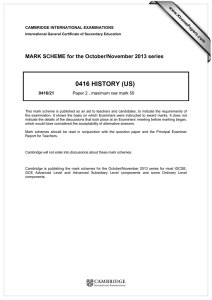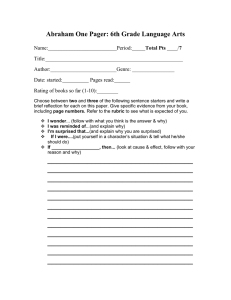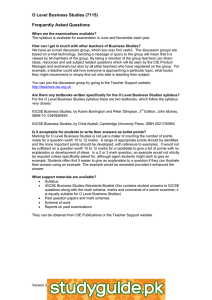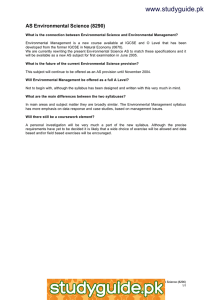0416 HISTORY (US) MARK SCHEME for the May/June 2013 series
advertisement
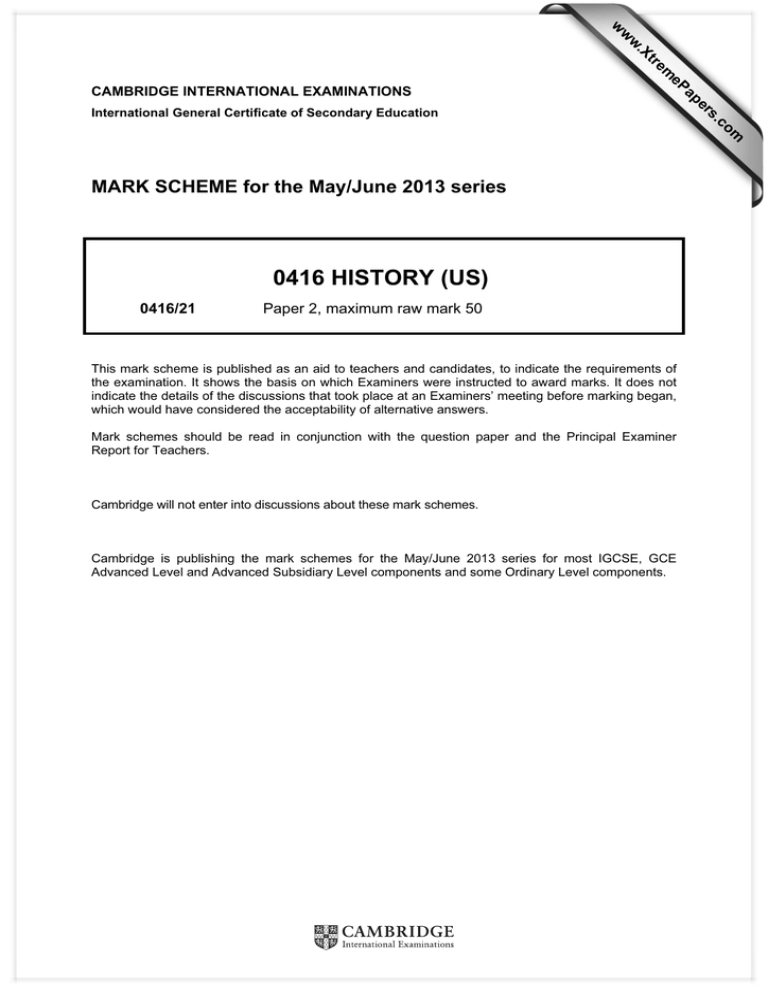
w w ap eP m e tr .X w CAMBRIDGE INTERNATIONAL EXAMINATIONS 0416 HISTORY (US) 0416/21 Paper 2, maximum raw mark 50 This mark scheme is published as an aid to teachers and candidates, to indicate the requirements of the examination. It shows the basis on which Examiners were instructed to award marks. It does not indicate the details of the discussions that took place at an Examiners’ meeting before marking began, which would have considered the acceptability of alternative answers. Mark schemes should be read in conjunction with the question paper and the Principal Examiner Report for Teachers. Cambridge will not enter into discussions about these mark schemes. Cambridge is publishing the mark schemes for the May/June 2013 series for most IGCSE, GCE Advanced Level and Advanced Subsidiary Level components and some Ordinary Level components. om .c MARK SCHEME for the May/June 2013 series s er International General Certificate of Secondary Education Page 2 Mark Scheme IGCSE – May/June 2013 Syllabus 0416 Paper 21 OPTION A: 19TH CENTURY TOPIC 1 Study Sources A and B. How far do these two sources agree? Explain your answer using details of the sources. [7] Level 0 No evidence submitted or response does not address the question [0] Level 1 Writes about the sources, no valid comparison [1] Level 2 Disagreement: information that is in one source but not in the other OR Agree: they are on the same topic 2 [2] Level 3 Agreement and/or disagreement of detail/sub-message [3–5] Level 4 Agreement on the Big Message/judgement – that overall Reconstruction had some achievements but was a failure in the end. [6–7] Study Sources C and D. How similar are these two sources? Explain your answer using details of the sources and your knowledge. [8] Level 0 No evidence submitted or response does not address the question [0] Level 1 Writes about the sources, no valid comparison [1] Level 2 Answers based on misinterpretations of both cartoons OR Compares provenance of sources [2] Level 3 Identifies sub-message(s) but no valid comparison [3] Level 4 Valid comparison of sub-message [4] Level 5 Identifies Big Message of one or both cartoons, but no valid comparison Level 6 Valid comparison of the Big Messages i.e. Source C is in favour of the Freedmen’s Bureau, Source D is against it. Level 7 Compares the purposes of the two sources i.e. intended impact on audience. The impact may relate either to the Freedmen’s Bureau or to Johnson. © Cambridge International Examinations 2013 [5–6] [7] [8] Page 3 3 Mark Scheme IGCSE – May/June 2013 Syllabus 0416 Paper 21 Study Source E. How surprised are you by this source? Explain your answer using details of the source and your knowledge. [8] Level 0 No evidence submitted or response does not address the question [0] Level 1 Writes about the sources, but fails to address surprise [1] Level 2 Identifies something surprising/not surprising, no explanation of why OR 4 Valid analysis of source, but fails to state surprised/not surprised. [2] Level 3 Assertions based on everyday empathy [3] Level 4 Surprised/not surprised: uses cross-reference or contextual knowledge to check details of the source. e.g. on whether what it says about the South is accurate. [4–5] Level 5 Surprised/not surprised about Johnson: explained by cross-reference to other source(s) [6] Level 6 Not surprised about Johnson: explained by contextual knowledge about him [7] Level 7 Not surprised about attitudes of people like Nordhoff: explained by contextual knowledge of radicals in the North. [8] Study Source F. What is the cartoonist’s message? Explain your answer using details of the source and your knowledge. [7] Level 0 No evidence submitted or response does not address the question [0] Level 1 Surface description of the cartoon [1] Level 2 Misinterpretation of the cartoon i.e. it’s mocking, hostile, critical etc. [2–3] Level 3 Interprets sub-message(s) [3–5] Level 4 Interprets Big Messge i.e. explains how it shows approval/admiration for the scholar. [6–7] © Cambridge International Examinations 2013 Page 4 5 6 Mark Scheme IGCSE – May/June 2013 Syllabus 0416 Paper 21 Study Source G. How useful is this source to a historian studying the results of Reconstruction? Explain your answer using details of the source and your knowledge. [8] Level 0 No evidence submitted or response does not address the question [0] Level 1 Writes about the source, no reference to utility [1] Level 2 Not useful: undeveloped evaluation e.g. Not useful because he’s a Southerner so won’t tell the truth. [2] Level 3 Useful for the information it provides i.e. uncritical acceptance that what it says is useful information [3] Level 4 Useful because reliable: explained by cross-reference to other source(s) [4] Level 5 Not useful because unreliable: explained evaluation of the source e.g. by cross-reference to other source(s)/contextual knowledge, explained provenance etc. [5–6] Level 6 Useful as evidence of how southerners would like to be perceived in the North. [7–8] Study all the sources. How far do these sources provide convincing evidence that Reconstruction improved the lives of black Americans? Use the sources to explain your answer. [8] Level 0 No evidence submitted or response does not address the question [0] Level 1 No valid source use [1–3] Level 2 Use sources to support or reject the statement [4–6] Level 3 Uses sources to support and reject the statement [7–10] Award up to 2 bonus marks for evaluation of sources (no more than 1 per source) Source use must be reference to a source by letter, by provenance or by direct quote. There must be examples from source content. There must be an explanation of how this supports/does not support the statement. Use Y in the margin for each source used in support of the statement, and N for each source used rejecting the statement. Yes No A B D F G (E) A B C H (E) Sources shown in brackets are unlikely to be used that way, but it is possible to make a valid argument. © Cambridge International Examinations 2013 Page 5 Mark Scheme IGCSE – May/June 2013 Syllabus 0416 Paper 21 OPTION B: 20TH CENTURY TOPIC 1 Study Sources A and B. How far do these two sources agree? Explain your answer using details of the sources. [7] Level 0 No evidence submitted or response does not address the question [0] Level 1 Writes about the sources, no valid comparison [1] Level 2 Disagreement: information that is in one source but not in the other OR Agree: they are on the same topic [2] Level 3 Agreements or disagreements of detail/sub-messages e.g. Agree that there were people in France who were unhappy with the Treaty/Disagree because Source A says Clemenceau was outwitted by Lloyd George, but B says he got what he wanted. [3–4] Level 4 Agreements and disagreements of detail/sub-messages © Cambridge International Examinations 2013 [5–7] Page 6 2 Mark Scheme IGCSE – May/June 2013 Syllabus 0416 Paper 21 Study Source C. Why was this source published in May 1919? Explain your answer using details of the source and your knowledge. [8] Level 0 No evidence submitted or response does not address the question [0] Level 1 Surface descriptions of the source [1] Level 2 Reason based on misinterpretations of the cartoon OR Interprets the cartoon/describes the context, but gives no reason for publication Level 3 [2] Reason based on context At this level context can be general, e.g. Because it was around the time the treaties were signed. OR Level 4 Level 5 Level 6 Reason based on a valid sub-message This will be on some aspect of the cartoon, e.g. Germany, Versailles, rather than on the Big Message. e.g. To show that Germany was being treated harshly. [3–4] Reason based on the Big Message This must be about all the treaties, or all the defeated powers. e.g. To show that the Allies are going to make sure that all the defeated powers get what they deserve. [5–6] Reason based on the purpose of the cartoonist ‘Purpose’ must show the intended impact on the audience of the cartoon. e.g. To make sure that pressure is kept up on the peacemakers to punish the defeated powers severely. [7] Reason based on purpose in specific context of May 1919 At this level awareness of context must include knowing that in May 1919 none of the treaties had yet been signed. [8] © Cambridge International Examinations 2013 Page 7 3 Mark Scheme IGCSE – May/June 2013 Syllabus 0416 Paper 21 Study Sources D and E. Does Source D prove that Source E is wrong? Explain your answer using details of the sources and your knowledge. [8] Level 0 No evidence submitted or response does not address the question [0] Level 1 Writes about the source, but fails to address the question [1] Level 2 Answers on undeveloped provenance e.g. It can’t because Source E is from a diary and people don’t lie in their diary. [2–3] Level 3 Compares sources for difference to say whether D proves E wrong e.g. Source D thinks that the Treaty is fair so it approves of it, but Source E admits that it is bad. Because of this, Source D shows Source E is wrong. [4–5] Level 4 Evaluates Source E with no reference to Source D e.g. I don’t think Source E is wrong. It says that the Americans were not pleased with the Treaty, and this was shown when Wilson went back to the USA and he could not persuade Congress to approve it. [6] Compares sources for difference, and evaluates one to judge whether Source E is wrong. e.g. Source D thinks that the Treaty is fair so it approves of it, and Source E admits that it is bad. But I don’t think Source E is wrong. It says that the Americans were not pleased with the Treaty, and this was shown when Wilson went back to the USA and he could not persuade congress to approve it. [7] Compares sources for difference, and evaluates both to judge whether Source E is wrong. e.g. [As L5 example plus] And you can’t really believe what Clemenceau is saying to the peace conference. He knows that France really wants revenge, and doesn’t care about justice, but in public he has to pretend that what they are doing is fair. [8] Level 5 Level 6 © Cambridge International Examinations 2013 Page 8 4 Mark Scheme IGCSE – May/June 2013 Syllabus 0416 Paper 21 Study Source F and G. How far would these two cartoonists have agreed with each other? Explain your answer using details of the sources and your knowledge. [8] Level 0 No evidence submitted or response does not address the question [0] Level 1 Surface comparisons e.g. Disagree because the USA wears a hat in B but not in A. [1] Answers based on undeveloped provenance e.g. Agree because they were both published in 1919. [2] Level 3 Interprets valid sub-message(s), but no valid comparison [3] Level 4 Interprets Big Message of one/both source(s), no valid comparison [4] Level 5 Compares valid sub-messages e.g. They would agree that Wilson has been the main person to set up the League of Nations. Level 2 [4–6] Level 6 Compares Big Message – that the League of Nations will fail [8] Level 7 As L6, but qualifies the answer with a disagreement on why the League will fail. [8] © Cambridge International Examinations 2013 Page 9 5 Mark Scheme IGCSE – May/June 2013 Syllabus 0416 Paper 21 Study Source H. Are you surprised by Source H? Explain your answer using details of the source and your knowledge. [7] Level 0 No evidence submitted or response does not address the question [0] Level 1 Writes about the source but fails to address surprise [1] Level 2 Identifies what is/is not surprising but no reason given OR Valid analysis of source, but fails to state surprised or not i.e. this is more than L1 because the answer would be valid if surprised/not surprised were made explicit. Level 3 [2] Assertions based on everyday empathy e.g. I’m not surprised you would want to punish somebody who had done an intolerable thing. They would deserve it. OR Level 4 Level 5 Level 6 Assertions about Wilson/the Treaty etc, using undeveloped context e.g. I am surprised Wilson says he wants to punish Germany because I thought he wanted a fair peace. [3] Explains surprised/not surprised, using cross-reference to other source. e.g. I am surprised he says he wants to punish Germany because if you look at Source F it seems like he wants everlasting peace between nations. [4] Uses developed contextual knowledge to explain surprised/not surprised At this level contextual knowledge must be something specific, e.g. the 14 Points. e.g. I am surprised that he says Germany must be made to pay because in his 14 Points, he made it clear that he wanted a peace based on fairness for all. [5–6] Not surprised he says he is being tough because he’s trying to sell the peace to a reluctant audience. i.e. shows contextual awareness of reaction in the USA to the peace treaties to explain why Wilson says what he does. © Cambridge International Examinations 2013 [7] Page 10 6 Mark Scheme IGCSE – May/June 2013 Syllabus 0416 Paper 21 Study all the sources. How far do these sources provide convincing evidence that the peacemakers got what they wanted from the peace settlement? Use the sources to explain your answer. [10] The ‘peacemakers’ are Lloyd George, Wilson and Clemenceau, along with the delegations at the peace conference and not the general populations of the victorious countries. Level 0 No evidence submitted or response does not address the question [0] Level 1 No valid source use [1–3] Level 2 Uses sources to support or reject the statement [4–6] Level 3 Uses sources to support and reject the statement [7–10] Award up to 2 bonus marks for evaluation of sources (no more than 1 per source) Source use must be reference to a source by letter, by provenance or by direct quote. There must be examples from source content. There must be an explanation of how this supports/does not support the statement. Use Y in the margin for each source used in support of the statement, and N for each source used rejecting the statement. Yes No B C D H (F) (G) A B E F G (C) Sources shown in brackets are unlikely to be used that way, but it is possible to make a valid argument. © Cambridge International Examinations 2013

